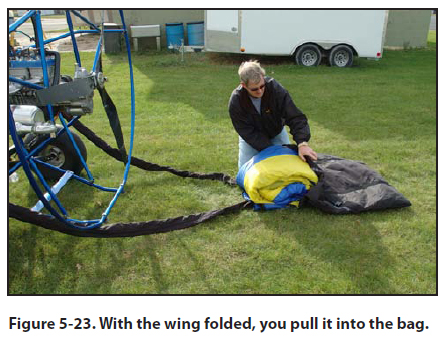|
Chapter 5 — Preflight and Ground Operations
Clearing the Runway
If a powered parachute lands on the center of a runway,
it is considered good practice to taxi to the edge
of or even off of the runway before collapsing the
wing and stowing equipment. When doing that, it is
important to keep the powered parachute moving after
landing to keep the wing inflated. The safest and
easiest method is to keep taxiing straight into the wind
until you clear the runway or landing area and can
collapse the parachute out of the way of other aircraft.
If you determine that winds are too strong or gusty to
taxi off of an active runway, an alternate landing area
should be chosen.
Parking
Unless parking in a designated, supervised area, you
should select a location which will prevent the propeller
blast of other airplanes from striking the powered
parachute broadside. The powered parachute engine is
not enclosed in a cowling and engine surfaces will be
extremely hot. Never assume a bystander will know
this; even though the engine is not operating, it can
still be dangerous.
Once out of the powered parachute, you should immediately
pull the trailing edge of the wing forward
toward the cart and roll the leading edge and cell
openings under the wing surface; this will prevent
gusts of air from grabbing the wing and pulling the
cart backward. After the wing is totally disabled from
becoming airborne, you can assist your passenger in
disembarking from the cart.
Postflight
A flight is never complete until the engine is shut down
and the aircraft is secure. A pilot should consider this
an essential part of any flight.
After engine shutdown and the passenger exits the
cart, the pilot should accomplish a postflight inspection.
This includes checking the general condition of
the aircraft. For additional departures, the oil should
be rechecked and fuel added if required. If the PPC is
going to be inactive for a period of time, put the wing
properly back in the bag to keep it out of the sun.
Packing the Wing
back into the wing bag at the end of the flight is a necessary
task. The care and method the pilot employs
for this critical task directly affects whether or not the
wing is easy to unpack for the next flight. The process
of folding the wing and returning it safely to its wing
bag takes little time and the powered parachute passenger
can lend a hand to the pilot in the process. If
the pilot is flying solo the process will take a little
longer, but the overall results will be the same and
this gives the pilot an opportunity to do a thorough
postflight inspection of both the wing itself and the
suspension lines.
After disembarking from the cart, the wing should be
repositioned in the inverted layout with the exception
that the cart/prop hoop will be positioned very close
to the trailing edge of the wing. At that time the line
sleeves should both be replaced on each set of suspension
lines. When the line sleeves are in place, the
two bundles and any suspension lines left showing
are placed on the exposed lower surface of the wing
where they will be neatly packaged for storage during
the folding process of the wing.
Starting with one outer trailing edge of the wing, draw
the wing surface up and over the surface of the wing
fabric to the very center of the wing. The same action
will then be completed on the leading edge of the wing
on the same side. The process is then completed two
more times on the same side. Then the wing is folded
from the other side three times in the same manner,
resulting in a long rectangle of wing lying directly
behind the prop line of the cart. This is one example;
it is important for you to follow the manufacturer’s
recommendations for your PPC.
The pilot then starts at the edge closest to the cart and
folds the sides of the folded wing alternately in on
each other, depressing the trapped air out of the fabric,
all the way to the farthest area away from the cart.
[Figure 5-22] Once this is complete, the wing package
size is established by taking the farthest edge and
folding it toward the cart over and over until a neat
square is obtained on the last fold.

After the wing is folded and lying on the ground behind
the cart, the wing bag is placed on the ground
next to the wing (on the side away from the cart).
[Figure 5-23] It is advised to have a “marked” side of the bag and always keep the marked side facing up
or in the same direction every time you load the wing
into the bag and onto the cart. The wing is then neatly
pulled into the bag. The pilot then picks the bag up on
end and gathers the line sleeves on top of the wing.
[Figure 5-24] Refer to the manufacturer’s recommendations
for loading the wing in its bag on the cart for
taxi and storage.
 
|

